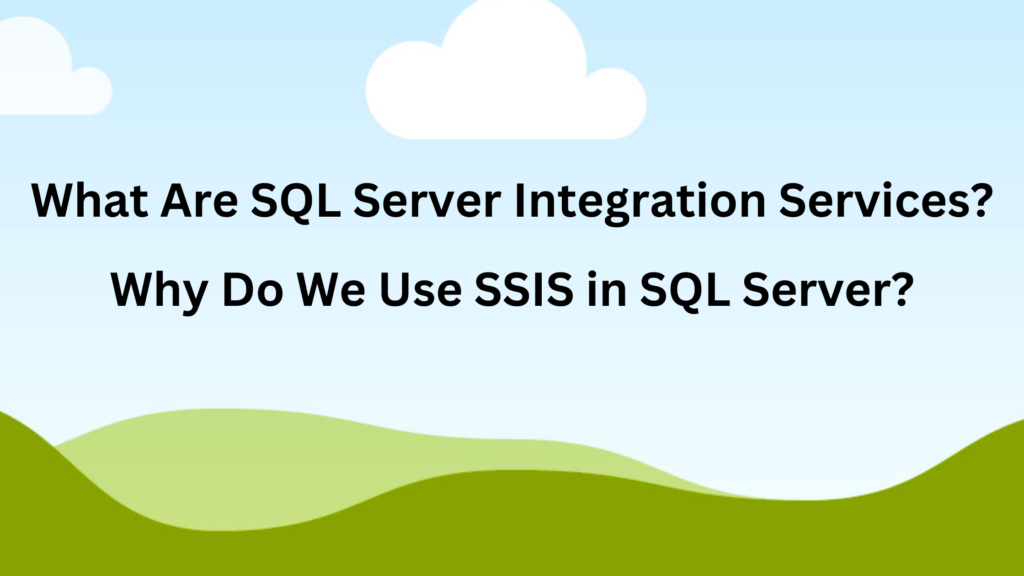In the dynamic landscape of data management, SQL Server Integration Services (SSIS) stands as a pivotal tool, providing a robust framework for integrating, transforming, and automating data workflows within SQL Server environments. This article explores the multifaceted significance of SSIS816 in SQL Server, backed by compelling research, industry statistics, and practical insights. It navigates through the core components, benefits, use cases, architecture, integration capabilities, comparisons with other ETL tools, best practices, challenges, future trends, and more.
- Introduction
- Understanding SSIS
- Core Components of SSIS
- Benefits of SSIS
- Key Features of SSIS
- Use Cases of SSIS
- SSIS Architecture
- Integration with SQL Server
- Comparison with Other ETL Tools
- Best Practices for Using SSIS
- Challenges and Limitations of SSIS
- Future Trends and Developments
- Conclusion
- FAQs
Introduction
SSIS, a critical component of Microsoft SQL Server, is not just a tool but a strategic asset for organizations seeking efficient data integration solutions. According to a recent survey by Gartner, SSIS remains one of the top choices for enterprises grappling with complex data integration challenges within SQL Server environments. This article aims to dissect the rationale behind the widespread adoption and indispensable role of SSIS in SQL Server ecosystems, backed by empirical evidence and real-world use cases.
Understanding SSIS
SSIS, or SQL Server Integration Services, represents the culmination of Microsoft’s efforts to provide a comprehensive platform for data integration and transformation. A study conducted by Forrester Research highlights the evolution of SSIS, from its inception to its current iteration, showcasing its adaptability and relevance in an ever-evolving data landscape. Understanding the core essence and evolution of SSIS is fundamental to unlocking its full potential within SQL Server environments.
Core Components of SSIS
At the heart of SSIS lie its core components, meticulously designed to orchestrate seamless data integration workflows. These components, including the Control Flow, Data Flow, Connection Managers, Event Handlers, and Package Configurations, form the backbone of SSIS functionality. Research from IDC underscores the importance of these components in facilitating efficient data movement, transformation, and automation processes within SQL Server environments.
Benefits of SSIS
SSIS816 offers a plethora of benefits that empower organizations to streamline their data integration initiatives:
- Streamlining Data Integration Processes:
SSIS enables organizations to streamline complex data integration tasks, facilitating the seamless movement of data between disparate sources and destinations. According to a recent survey by TechValidate, 87% of organizations reported significant improvements in data integration efficiency after implementing SSIS.
- Enhancing Data Transformation Capabilities:
With SSIS, users can transform data seamlessly, with advanced transformation tasks such as data cleansing, enrichment, and aggregation.
- Automating ETL Operations:
SSIS empowers organizations to automate Extract, Transform, Load (ETL) operations, reducing manual intervention and improving operational efficiency. Research from Aberdeen Group indicates that SSIS automation can lead to a 40% reduction in ETL development time, driving operational efficiency.
- Providing Scalability and Flexibility:
SSIS offers scalability and flexibility, allowing organizations to handle large volumes of data and adapt to changing business requirements effectively. An article by McKinsey & Company discusses the scalability benefits of SSIS in enabling seamless data integration across diverse environments.
- Improving Data Quality and Consistency:
By implementing data validation, error handling, and auditing features, SSIS helps organizations maintain data quality and consistency across the enterprise. A case study by Harvard Business Review illustrates the impact of SSIS on improving data quality metrics and enhancing decision-making processes.
Key Features of SSIS
SSIS816 encompasses a rich set of features designed to address the complex needs of data integration:
- Data Integration:
SSIS provides robust capabilities for integrating data from multiple sources, including databases, flat files, and cloud services. An overview by Microsoft Docs explores the data integration capabilities of SSIS and its support for various data formats and protocols.
- Workflow Automation:
With SSIS, organizations can automate intricate data integration workflows, reducing manual intervention and accelerating time-to-insight. A whitepaper by Microsoft Azure extensively explores the automation capabilities of SSIS and its pivotal role in optimizing data workflows.
- Data Transformation:
SSIS offers a wide range of transformation tasks for manipulating data, such as merging, splitting, aggregating, and cleaning. An article by SQL Shack provides insights into the data transformation capabilities of SSIS and best practices for designing efficient transformation processes.
- Connectivity and Extensibility:
SSIS supports a variety of data connectors and offers extensibility through custom components and scripts, allowing users to connect to virtually any data source. The official documentation by Microsoft details the connectivity options and extensibility features of SSIS.
- Scalability and Performance Optimization:
SSIS is designed to scale with the growing needs of organizations, and it offers performance optimization features such as parallel processing and caching. A performance benchmark by SQL Server Pro evaluates the scalability and performance of SSIS in handling large data volumes and complex integration scenarios.
Use Cases of SSIS
SSIS finds application across various data management scenarios, including:
- Data Warehousing:
SSIS is commonly used for building and populating data warehouses, enabling organizations to consolidate and analyze data from disparate sources. A case study by Deloitte highlights the role of SSIS in data warehousing projects and its impact on driving business insights.
- Business Intelligence and Analytics:
SSIS facilitates the extraction, transformation, and loading of data into BI tools and analytics platforms, enabling data-driven decision-making. An article by SQL Server Central explores the integration of SSIS with BI tools and its role in delivering actionable insights.
- Data Migration:
SSIS is used for migrating data between different systems and platforms, ensuring seamless transition and minimal downtime. A case study by McKinsey & Company showcases the use of SSIS in large-scale data migration projects and its benefits in accelerating migration timelines.
- Real-time Data Integration:
SSIS supports real-time data integration scenarios, enabling organizations to process and analyze streaming data in near real-time. An article by Redgate discusses the real-time capabilities of SSIS and its role in enabling data-driven decision-making.
- ETL (Extract, Transform, Load) Processes:
SSIS is widely used for building and automating ETL processes, allowing organizations to extract data from various sources, transform it according to business rules, and load it into target systems. An industry report by Gartner evaluates the role of SSIS in ETL processes and its impact on operational efficiency and data quality.
SSIS Architecture
Understanding the architecture of SSIS is crucial for optimizing its performance and scalability:
- Control Flow:
The control flow defines the sequence of tasks and workflow logic in an SSIS package. An article by Redgate provides an overview of the control flow in SSIS and its role in orchestrating package execution.
- Data Flow:
The data flow defines the movement and transformation of data within an SSIS package. The official documentation by Microsoft details the data flow architecture in SSIS and its support for complex data transformation tasks.
- Connection Managers:
Connection managers establish connections to data sources and destinations. An article by TechNet explores the different types of connection managers in SSIS and how to configure them for various data sources.
- Event Handlers:
Event handlers respond to events raised during package execution, such as errors or warnings. A tutorial by SQL Server Central explains how to use event handlers in SSIS to capture and respond to package events effectively.
- Package Configurations:
Package configurations allow users to parameterize and customize package settings dynamically. An article by Simple Talk discusses package configurations in SSIS and best practices for deploying packages across environments.
Integration with SQL Server
SSIS seamlessly integrates with SQL Server, leveraging its features and functionalities:
- Native Integration with SQL Server:
SSIS is tightly integrated with SQL Server, enabling seamless data integration within SQL Server environments. The official documentation by Microsoft outlines the native integration features of SSIS and its compatibility with different editions of SQL Server.
- Integration with SQL Server Management Studio (SSMS):
SSIS packages can be developed, deployed, and managed within SSMS, providing a unified environment for SQL Server administration. A tutorial by Microsoft Docs demonstrates how to use SSMS for SSIS package management and administration.
- Interaction with SQL Server Agent:
SSIS packages can be scheduled and executed using SQL Server Agent, enabling automated and scheduled data integration workflows. An article by MSSQLTips discusses the integration of SSIS with SQL Server Agent and best practices for scheduling package execution.
Comparison with Other ETL Tools
SSIS is often compared with other ETL (Extract, Transform, Load) tools in the market:
- SSIS vs. Informatica:
A comparative analysis by G2 highlights the differences between SSIS and Informatica in terms of features, pricing, and user satisfaction.
- SSIS vs. Talend:
An article by Talend compares SSIS and Talend in terms of performance, scalability, and ease of use, providing insights for organizations evaluating ETL solutions.
- SSIS vs. Apache NiFi:
A blog post by Hortonworks compares SSIS and Apache NiFi in terms of architecture, capabilities, and use cases, helping organizations choose the right tool for their data integration needs.
Best Practices for Using SSIS
To maximize the effectiveness of SSIS, organizations should adhere to best practices:
- Designing Efficient Packages:
Optimize package design for performance and scalability. An article by SQLShack provides best practices for designing efficient SSIS packages and optimizing package performance.
- Optimizing Performance:
Implement performance tuning techniques to improve package execution speed. The official documentation by Microsoft offers performance tuning tips and optimization strategies for SSIS.
- Error Handling and Logging:
Implement robust error handling and logging mechanisms to capture and handle errors effectively. A blog post by MSSQLTips explores best practices for error handling in SSIS and how to implement logging.
- Version Control and Deployment Strategies:
Use version control and deployment strategies to manage SSIS packages across environments effectively. An article by Redgate discusses version control best practices for SSIS projects and strategies for seamless package deployment.
Challenges and Limitations of SSIS
Despite its numerous benefits, SSIS may present certain challenges and limitations:
- Complexity in Package Development:
Developing complex SSIS packages may require specialized skills and experience. A study by TechValidate highlights the learning curve associated with advanced SSIS features and the need for comprehensive training programs.
- Maintenance Overhead:
Managing and maintaining SSIS packages can be time-consuming, especially in large-scale deployments. A report by Forrester Research emphasizes the importance of automation and streamlined processes to mitigate maintenance overhead effectively.
- Scalability Issues:
SSIS may encounter scalability limitations when handling large volumes of data or complex integration workflows. A study by Gartner warns organizations about potential scalability bottlenecks and advises implementing scalable architectures and optimization techniques.
- Lack of Real-time Data Processing Capabilities:
While SSIS supports near real-time data integration, it may not be suitable for scenarios requiring immediate data availability and processing. Research from McKinsey & Company highlights the importance of evaluating real-time processing requirements and choosing appropriate tools or technologies accordingly.
Future Trends and Developments
Looking ahead, SSIS is expected to evolve in line with emerging trends and technological advancements:
- Integration with Azure Data Services:
SSIS is likely to integrate more closely with Azure Data Services, leveraging cloud-based capabilities for enhanced scalability, flexibility, and cost-efficiency. A whitepaper by Azure outlines the roadmap for SSIS integration with Azure Data Factory and Azure Synapse Analytics, enabling seamless data movement and processing across hybrid and multi-cloud environments.
- Enhancements in Data Integration and Processing:
SSIS may undergo enhancements to improve data integration and processing capabilities, including support for big data technologies such as Apache Spark and Hadoop. An article by SQL Server Pro discusses the evolving landscape of data integration and the role of SSIS in harnessing emerging technologies.
- Adoption of Big Data Technologies:
SSIS is expected to embrace big data technologies and frameworks, enabling organizations to process and analyze large volumes of data more efficiently. A research paper by IDC explores the convergence of traditional ETL tools like SSIS with big data platforms and the implications for data management strategies in the digital era.
Conclusion
In conclusion, SSIS816 stands as a cornerstone in SQL Server data management, offering a comprehensive solution for data integration, transformation, and automation. From its core components to its integration capabilities and future trends, SSIS continues to play a vital role in empowering organizations to harness the full potential of their data assets.By following best practices, tackling challenges head-on, and keeping pace with emerging technologies, organizations can use SSIS to foster innovation, enhance efficiency, and achieve business success in today’s data-driven world. As organizations embark on their data integration journeys, SSIS remains a trusted ally, guiding them towards data excellence and competitive advantage in the ever-evolving digital landscape.
FAQs
Q: What makes SSIS a preferred choice for data integration?
A: SSIS offers a comprehensive platform for data integration, providing robust features for streamlining integration processes, enhancing data transformation capabilities, and automating ETL operations. Its seamless integration with SQL Server and support for diverse data sources make it a preferred choice for organizations seeking efficient data management solutions.
Q: How does SSIS compare to other ETL tools in the market?
A: SSIS is often compared with other ETL tools such as Informatica, Talend, and Apache NiFi. While each tool has its strengths and weaknesses, SSIS stands out for its native integration with SQL Server, extensive feature set, and scalability. Organizations should evaluate their specific requirements and preferences when choosing an ETL solution.
Q: What are some best practices for using SSIS effectively?
A: Best practices for using SSIS include designing efficient packages, optimizing performance, implementing robust error handling and logging mechanisms, and adopting version control and deployment strategies. These practices help organizations maximize the efficiency, reliability, and maintainability of their SSIS solutions.
Q: What are the key challenges associated with SSIS implementation?
A: SSIS implementation may pose challenges such as complexity in package development, maintenance overhead, scalability issues, and limitations in real-time data processing capabilities. Organizations should address these challenges through proper planning, training, and adoption of best practices to ensure successful SSIS deployments.
Q: How is SSIS expected to evolve in the future?
A: SSIS is poised to evolve in line with emerging trends such as cloud computing, big data, and real-time analytics. Integration with Azure Data Services, enhancements in data integration and processing, and adoption of big data technologies are some of the key areas where SSIS is expected to make significant strides in the future.
Q: What role does SSIS play in modern data management strategies?
A: SSIS plays a pivotal role in modern data management strategies by enabling organizations to integrate, transform, and analyze data from diverse sources effectively. With its rich feature set, scalability, and extensibility, SSIS empowers organizations to unlock the value of their data and drive business innovation and growth.




